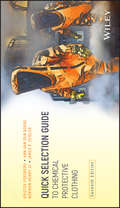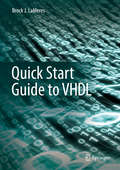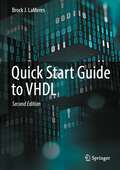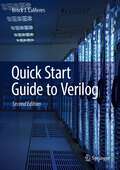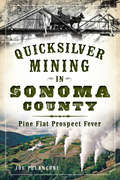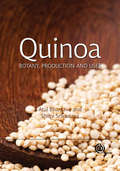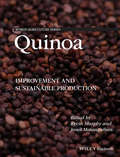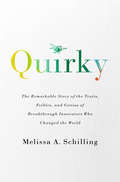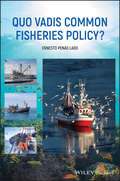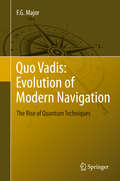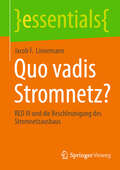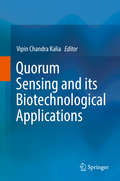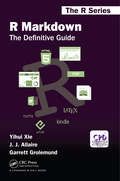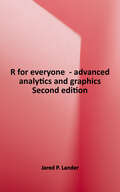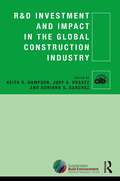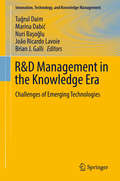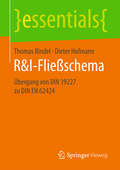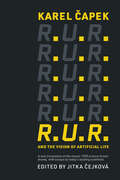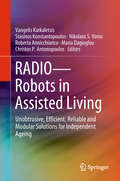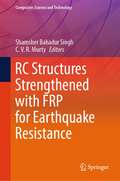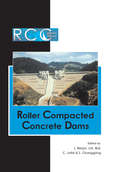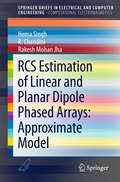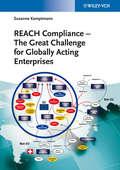- Table View
- List View
Quick Selection Guide to Chemical Protective Clothing
by James P. Zeigler Krister Forsberg Norman Henry III Ann Van den BorreQuick Selection Guide to Chemical Protective Clothing provides the reader with the latest information on Selection, Care and Use of Chemical Protective garments and gloves. Topics in the widely-used reference guide include Selection and Use of Chemical Protective Clothing, Chemical Index, Selection Recommendations, Glossary, Standards for Chemical Protective Clothing, Manufactures of Chemical Protective Clothing and European requirements for chemical resistant gloves.The key feature of the book is the color-coded selection recommendations. The red, yellow or green indications are highly appreciated by the users. This sixth edition of the Quick Selection Guide to Chemical Protective Clothing has been updated, to include approximately 1,000 chemicals/chemical brands or mixture of chemicals more than twice the information provided in the original edition. The performance of 9 generic materials and 32 proprietary barriers are compared against the 21 standard test chemicals listed in ASTM F1001. The color-coded recommendations against the broader list of materials now contain 27 representative barrier materials. This best selling pocket guide is the an essential field source for HazMat teams, spill responder, safety professionals, chemists and chemical engineers, industrial hygienists, supervisors, purchase agents, salespeople and other users of chemical protective clothing.
Quick Selection Guide to Chemical Protective Clothing
by James P. Zeigler Krister Forsberg Norman Henry III Ann Van den BorreThe expanded seventh edition, complete with new materials and updated information on existing materials for chemical protective clothing The revised and updated seventh edition of Quick Selection Guide to Chemical Protective Clothing contains the most recent information on the selection, use, and care of chemical protective clothing, such as protective gloves, suits, and other garments. The seventh edition includes new selection recommendations, new materials and chemicals tested, and updated information on existing products. This accessible guide also contains the popular color-coded selection grid. The grid system indicates which materials offer protection against specific chemicals, and which do not. Selecting the most appropriate chemical protective clothing is essential for the prevention of illnesses and injures from hazardous chemical exposure, especially where other control measures are not feasible. Written by noted experts on the topic, the book has been thoroughly revised to reflect the most recent advances in the field. The new seventh edition: • Offers an updated Trade Name Table with 25 product name changes, 8 new products, and 10 products deletions • Includes 27 products in the Master Chemical Resistance Table with changed names and includes replaces outdated products with important new ones • Contains new selection recommendations (color codes) that reflect new chemicals and additional tests • Includes 1,000 chemicals in the index that are linked to the UN pictograms and Risk Codes related to skin exposure • Provides a guide for comparing the performance of available product/barrier materials currently on the market Written for anyone responsible for the purchase or use of protective clothing, the updated seventh edition of Quick Selection Guide to Chemical Protective Clothing is a pocket guide that is the only independent source for selection of chemical protective clothing.
Quick Start Guide to VHDL
by Brock J. LaMeresThis textbook provides a starter’s guide to VHDL. This book can be used in conjunction with a one-semester course in Digital Systems Design or on its own for designers who only need an introduction to the language. This book is designed to provide a bottoms-up approach to learning the VHDL language. This design supports a course in which foundational knowledge is covered before moving into advanced topics. However, this design also supports use as a reference manual. The author has designed the presentation with learning goals and assessment at its core. Each section addresses a specific learning outcome that the student should be able to “do” after its completion. The concept checks and exercise problems provide a rich set of assessment tools to measure student performance on each outcome.
Quick Start Guide to VHDL
by Brock J. LaMeresThis textbook provides a starter’s guide to VHDL. This book can be used in conjunction with a one-semester course in Digital Systems Design or on its own for designers who only need an introduction to the language. This book is designed to provide a bottoms-up approach to learning the VHDL language. This design supports a course in which foundational knowledge is covered before moving into advanced topics. However, this design also supports use as a reference manual. The author has designed the presentation with learning goals and assessment at its core. Each section addresses a specific learning outcome that the student should be able to “do” after its completion. The concept checks and exercise problems provide a rich set of assessment tools to measure student performance on each outcome.
Quick Start Guide to Verilog
by Brock J. LaMeresThis textbook provides a starter’s guide to Verilog, to be used in conjunction with a one-semester course in Digital Systems Design, or on its own for readers who only need an introduction to the language. This book is designed to match the way the material is actually taught in the classroom. Topics are presented in a manner which builds foundational knowledge before moving onto advanced topics. The author has designed the presentation with learning goals and assessment at its core. Each section addresses a specific learning outcome that the student should be able to “do” after its completion. The concept checks and exercise problems provide a rich set of assessment tools to measure student performance on each outcome.Written the way the material is taught, enabling a bottom-up approach to learning which culminates with a high-level of learning, with a solid foundation;Emphasizes examples from which students can learn: contains a solved example for nearly every section in the book;Includes more than 200 exercise problems, as well as concept check questions for each section, tied directly to specific learning outcomes.
Quicksilver Mining in Sonoma County: Pine Flat Prospect Fever
by Joe PelanconiIn the 1870s, a quicksilver mining boom took hold of Sonoma County, California. Claims were staked, and a rowdy camp took shape in Pine Flat as farmers traded plows for picks and miners answered the siren call of cinnabar. In this compelling account, historian Joe Pelanconi relates the development of the twenty-mile Cinnabar Mining District. Pelanconi shares intriguing stories like those of the Donner Party survivor, Chinese laborers who worked the mines in danger of mercury poisoning and the two brothers who were leading citizens of the district and purported victims of murder. Delve into Sonoma County's heritage and a lost era when eccentrics and dreamers sought shining flasks of riches in the Mayacamas Mountains above today's wine country.
Quinoa
by Shilpi Srivastava Didier Bazile Enrique A Martínez Atul Bhargava Francisco Fuentes* Quinoa is an invaluable crop, highlighted by the FAO as one of the world's main crops for future food security * Timely publication - The year 2013 has been declared "The International Year of the Quinoa" (IYQ), recognizing the Andean indigenous peoples, who have maintained, controlled, protected and preserved quinoa as food for present and future generations thanks to their traditional knowledge and practices of living well in harmony with mother earth and nature. * Covers the history, phylogeny and systematics, botany and agrotechnology
Quinoa
by Kevin S. Murphy Janet MatanguihanQuinoa is an ancient grain that has grown in popularity in recent years. It has been known as a good source of both protein and fiber. As the demand for quinoa increases a comprehensive and up-to-date reference on the biology and production of the crop is essential. Quinoa: Improvement and Sustainable Production brings together authors from around the world to provide a complete assessment of the current state of global quinoa research and production. Topics covered include quinoa history and culture, genomics and breeding, agronomy, nutrition, marketing, and end-uses. The book focuses in particular on the emerging role of quinoa in providing increased food security to smallholder farmers and communities throughout the world. Quinoa will interest quinoa researchers, producers, crop scientists, agronomists, and plant geneticists, as well as advanced students working with this important grain.
Quinoa: Botany, Production and Uses (Botany, Production and Uses)
by Shilpi Srivastava Atul Bhargava* Quinoa is an invaluable crop, highlighted by the FAO as one of the world’s main crops for future food security * Timely publication – The year 2013 has been declared "The International Year of the Quinoa" (IYQ), recognizing the Andean indigenous peoples, who have maintained, controlled, protected and preserved quinoa as food for present and future generations thanks to their traditional knowledge and practices of living well in harmony with mother earth and nature. * Covers the history, phylogeny and systematics, botany and agrotechnology
Quirky: The Remarkable Story of the Traits, Foibles, and Genius of Breakthrough Innovators Who Changed the World
by Melissa A SchillingThe science behind the traits and quirks that drive creative geniuses to make spectacular breakthroughsWhat really distinguishes the people who literally change the world--those creative geniuses who give us one breakthrough after another? What differentiates Marie Curie or Elon Musk from the merely creative, the many one-hit wonders among us?Melissa Schilling, one of the world's leading experts on innovation, invites us into the lives of eight people--Albert Einstein, Benjamin Franklin, Elon Musk, Dean Kamen, Nikola Tesla, Marie Curie, Thomas Edison, and Steve Jobs--to identify the traits and experiences that drove them to make spectacular breakthroughs, over and over again. While all innovators possess incredible intellect, intellect alone, she shows, does not create a breakthrough innovator. It was their personal, social, and emotional quirkiness that enabled true genius to break through--not just once but again and again.Nearly all of the innovators, for example, exhibited high levels of social detachment that enabled them to break with norms, an almost maniacal faith in their ability to overcome obstacles, and a passionate idealism that pushed them to work with intensity even in the face of criticism or failure. While these individual traits would be unlikely to work in isolation--being unconventional without having high levels of confidence, effort, and goal directedness might, for example, result in rebellious behavior that does not lead to meaningful outcomes--together they can fuel both the ability and drive to pursue what others deem impossible. Schilling shares the science behind the convergence of traits that increases the likelihood of success. And, as Schilling also reveals, there is much to learn about nurturing breakthrough innovation in our own lives--in, for example, the way we run organizations, manage people, and even how we raise our children.
Quo Vadis Common Fisheries Policy?
by Ernesto Penas LadoOffers a guide and provides an analysis of how a public European fisheries policy should be evaluated, implemented, and reformed Quo Vadis Common Fisheries Policy? is an essential book that provides an authoritative guide to the future challenges that face the public European fisheries policy. Written by a noted expert with 30 years’ experience in fisheries policies, the book provides the information needed to analyze how a public EU policy should be evaluated, implemented, and reformed. The book examines the difficulties of implementing the new policy including the application of the objectives of the 2013 policy reform. The author explores the myriad challenges that face the new policy due to global warming, pollution, and other global drivers. The book compares the new policy with other fisheries policy, particularly with the United States fisheries policy under the Magnusson-Stevens Act. The book offers an opportunity to address and discuss the challenges and obstacles that are not currently in the public domain. This important book: Provides a unique view from a noted expert and former policy insider Offers a critical analysis of a public EU policy from a pro-European standpoint. Gives a foundational resource to aid in the debate on the future of the Common Fisheries Policy Includes topics that go beyond EU’s policy and have implications for fisheries’ management around the world Written for administrations and stakeholders in the European and international fishing industry, Quo Vadis Common Fisheries Policy? addresses the challenges of EU’s new fisheries policy and offers a comparison of the US fisheries policy. The book helps foster much-needed debate about this topic.
Quo Vadis: Evolution of Modern Navigation
by F. G. MajorQuo Vadis: Evolution of Modern Navigation presents an intelligent and intelligible account of the essential principles underlying the design of satellite navigational systems--with introductory chapters placing them in context with the early development of navigational methods. The material is organized roughly as follows: the first third of the book deals with navigation in the natural world, the early history of navigation, navigating by the stars, precise mechanical chronometers for the determination of longitude at sea, and the development of precise quartz controlled clocks. Then, the reader is introduced to quantum ideas as a lead in to a discussion of microwave and optical interactions with atoms, atomic clocks, laser gyrocompasses, and time based navigation. The final third of the book deals with satellite-based systems, including orbit theory, early satellite navigation systems, and a detailed treatment of the Global Positioning System (GPS). Intended for non-specialists with some knowledge of physics or engineering at the college level, this book covers in an intuitive manner a broad range of topics relevant to the evolution of surface and space navigation, with minimum mathematical formalism.
Quo vadis Stromnetz?: RED III und die Beschleunigung des Stromnetzausbaus (essentials)
by Jacob F. LinnemannDer Stromnetzausbau ist essenziell für das Gelingen der Energiewende in Deutschland. Um die komplexen Planungs- und Genehmigungsverfahren hierfür zu beschleunigen, hat der europäische Gesetzgeber mit der novellierten Erneuerbare-Energien-Richtlinie (RED III) einen grundlegend neuen Weg eingeschlagen. Was verändert sich durch RED III und die nationale Umsetzung in Deutschland beim Stromnetzausbau? Wie wirken sich die Neuregelungen auf die Beschleunigung aus? Nach einem Überblick über die Inhalte der Richtlinie und der geplanten Umsetzung in Deutschland wird der Blick auf die Praxis gerichtet. Aktuelle Einschätzungen zu den Neuregelungen aus verschiedenen Perspektiven zeigen unterschiedliche Sichtweisen und Erwartungen. Einige wesentliche Aspekte können dabei für die Beschleunigungswirkung der neuen Regelungen entscheidend sein.
Quorum Sensing and its Biotechnological Applications
by Vipin Chandra KaliaThis book delves into the biotechnological applications of Quorum sensing (QS)- a peculiar gene-regulatory process of some microorganisms. Quorum Sensing allows a large bacterial population to work together in a coordinated manner to carry out metabolic activities, which individual bacterium cannot. The different chapters describe how, associating bioremediation process with energy generation is an economical proposal, for reducing pollution and managing biowastes. The book discusses how QS can be exploited for biotechnological applications in generating bioproducts, bioenergy, bioremediation, biosensors, health and agricultural activities. It further highlights how QS is becoming an integral part of synthetic biology for genetic circuits for producing: (i) novel products, (ii) biosensors, (iii) bioactive molecules, etc. The book is divided into different sections for a clear understanding of the applicability of QS in, the Environment, Energy, Agriculture and Health sectors.
R Markdown: The Definitive Guide (Chapman & Hall/CRC The R Series)
by Garrett Grolemund J. J. Allaire Yihui Xie<p>R Markdown: The Definitive Guide is the first official book authored by the core R Markdown developers that provides a comprehensive and accurate reference to the R Markdown ecosystem. With R Markdown, you can easily create reproducible data analysis reports, presentations, dashboards, interactive applications, books, dissertations, websites, and journal articles, while enjoying the simplicity of Markdown and the great power of R and other languages. <p>In this book, you will learn <p> <li>Basics: Syntax of Markdown and R code chunks, how to generate figures and tables, and how to use other computing languages <li>Built-in output formats of R Markdown: PDF/HTML/Word/RTF/Markdown documents and ioslides/Slidy/Beamer/PowerPoint presentations <li>Extensions and applications: Dashboards, Tufte handouts, xaringan/reveal.js presentations, websites, books, journal articles, and interactive tutorials <li>Advanced topics: Parameterized reports, HTML widgets, document templates, custom output formats, and Shiny documents. </p></li> <P><P><i>Advisory: This book offers only partial accessibility. We have kept it in the collection because it is useful for some of our members. Benetech is actively working on projects to improve accessibility issues such as these in the future.</i>
R for Everyone: Advanced Analytics and Graphics, Second Edition
by Jared P. LanderStatistical Computation for Programmers, Scientists, Quants, Excel Users, and Other Professionals Using the open-source R language, you can build powerful statistical models to answer many of your most challenging questions. R has traditionally been difficult for non-statisticians to learn, and most R books assume far too much knowledge to be of help. R for Everyone, Second Edition, is the solution. Drawing on his unsurpassed experience teaching new users, professional data scientist Jared P. Lander has written the perfect tutorial for anyone new to statistical programming and modeling. Organized to make learning easy and intuitive, this guide focuses on the 20 percent of R functionality you’ll need to accomplish 80 percent of modern data tasks. Lander’s self-contained chapters start with the absolute basics, offering extensive hands-on practice and sample code. You’ll download and install R; navigate and use the R environment; master basic program control, data import, manipulation, and visualization; and walk through several essential tests. Then, building on this foundation, you’ll construct several complete models, both linear and nonlinear, and use some data mining techniques. After all this, you’ll make your code reproducible with LaTeX, RMarkdown, and Shiny. By the time you’re done, you won’t just know how to write R programs, you’ll be ready to tackle the statistical problems you care about most.
R&D Investment and Impact in the Global Construction Industry (Cib Ser.)
by Adriana X. Sanchez Keith D. Hampson Judy A. KraatzR&D Investment and Impact in the Global Construction Industry brings together contributions from leading industry researchers in a diverse group of countries to investigate the role of research and development (R&D) in the construction industry. Investment in R&D is a proven factor in economic growth, and helps develop a more productive and innovative industry. This book explores how policy makers and industry leaders can better target future investment; and how industry and researchers can manage their efforts to improve productivity whilst addressing the environmental and social needs of their communities. Case studies present projects where R&D ideas funded by both the private and public sectors have been translated from research into practice or policy, and examine drivers, successes and barriers to the delivery of R&D in industry. Based on research from members of the CIB Task Group 85 (R&D Investment and Impact) and concluding with key insights for maximising the impact of R&D in the future, the book holds valuable lessons for practitioners, policy makers and researchers across the international construction industry.
R&D Management in the Knowledge Era: Challenges of Emerging Technologies (Innovation, Technology, and Knowledge Management)
by Tuğrul Daim Marina Dabić Nuri Başoğlu João Ricardo Lavoie Brian J. GalliThis volume explores emerging models, methods and tools in the management of research and development (R&D) in the knowledge era, with a particular focus on the challenges of the emerging technologies. The contributions are organized in five parts. Part I, Managing Emerging Technologies, provides methods and tools to understand the challenges created by the emergence of new technologies. Part II, Technology and Engineering Management Tools and Policies, explores different technology and engineering tools, including topics such as product concept development, design, selection and adoption, using technology roadmaps and bibliometrics. Part III, Technological Innovation and Entrepreneurship, explores R&D, knowledge transfer and entrepreneurial education. Part IV, Commercialization of Technological Innovations, explores the development and application of the technology transfer process which allows managers to succeed in commercializing the outcomes of R&D projects. Part V, Managing the Engineering Enterprise, explores the effect economic decision-making, leadership styles, change management and quality management have on an organization’s ability to plan and execute initiatives and projects. Research and Development has always played a critical role in the engineering and technology focused industries. In an era of big data and smart applications, knowledge has become a key enabler for R&D. Managing R&D in the knowledge era requires use of key tools and methods. However, emerging technologies pose many challenges and cause uncertainties or discontinuities, which make the task of managing R&D even more difficult. This book will examine these challenges and provide tools and methods to overcome them. Exploring such industries as automotive, healthcare, business intelligence, energy and home appliances, this book is a valuable resource for academics, scholars, professionals and leaders in innovation, R&D, technology, and engineering management.
R&I-Fließschema: Übergang von DIN 19227 zu DIN EN 62424 (essentials)
by Dieter Hofmann Thomas BindelThomas Bindel und Dieter Hofmann arbeiten Gemeinsamkeiten und Unterschiede der Normen DIN 19227 und DIN EN 62424 für die Erarbeitung von R&I-Fließschemata/R&I-Fließbildern heraus. DIN 19227, Teil 1 (Graphische Symbole und Kennbuchstaben für die Prozeßleittechnik) wurde zurückgezogen und durch DIN EN 62424 (Darstellung von Aufgaben der Prozessleittechnik – Fließbilder und Datenaustausch zwischen EDV-Werkzeugen zur Fließbilderstellung und CAE-Systemen) ersetzt, galt jedoch bis Juli 2012 fort. Da Fließschemata älterer Anlagen nach DIN 19227 erarbeitet wurden, stehen Anwender vor der Herausforderung, diese Norm nach wie vor verstehen zu müssen, für neu errichtete Anlagen dagegen DIN EN 62424 anzuwenden, die sich eher zögerlich durchzusetzen scheint. Die Autoren beleuchten die mit dem Übergang verbundenen Änderungen und geben so Orientierung zur Nutzung von DIN EN 62424.
R.U.R. and the Vision of Artificial Life
by Karel CapekA new translation of Karel Čapek&’s play R.U.R.—which famously coined the term &“robot&”—and a collection of essays reflecting on the play&’s legacy from scientists and scholars who work in artificial life and robotics.Karel Čapek's &“R.U.R.&” and the Vision of Artificial Life offers a new, highly faithful translation by Štěpán Šimek of Czech novelist, playwright, and critic Karel Čapek&’s play R.U.R.: Rossum&’s Universal Robots, as well as twenty essays from contemporary writers on the 1920 play. R.U.R. is perhaps best known for first coining the term &“robot&” (in Czech, robota means serfdom or arduous drudgery). The twenty essays in this new English edition, beautifully edited by Jitka Čejková, are selected from Robot 100, an edited collection in Czech with perspectives from 100 contemporary voices that was published in 2020 to celebrate the hundredth anniversary of the play.Čapek&’s robots were autonomous beings, but biological, not mechanical, made of chemically synthesized soft matter resembling living tissue, like the synthetic humans in Blade Runner, Westworld, or Ex Machina. The contributors to the collection—scientists and other scholars—explore the legacy of the play and its connections to the current state of research in artificial life, or ALife. Throughout the book, it is impossible to ignore Čapek&’s prescience, as his century-old science fiction play raises contemporary questions with respect to robotics, synthetic biology, technology, artificial life, and artificial intelligence, anticipating many of the formidable challenges we face today.ContributorsJitka Čejková, Miguel Aguilera, Iñigo R. Arandia, Josh Bongard, Julyan Cartwright, Seth Bullock, Dominique Chen, Gusz Eiben, Tom Froese, Carlos Gershenson, Inman Harvey, Jana Horáková, Takashi Ikegami, Sina Khajehabdollahi, George Musser, Geoff Nitschke, Julie Nováková, Antoine Pasquali, Hemma Philamore, Lana Sinapayen, Hiroki Sayama, Nathaniel Virgo, Olaf Witkowski
RADIO--Robots in Assisted Living: Unobtrusive, Efficient, Reliable and Modular Solutions for Independent Ageing
by Nikolaos S. Voros Christos P. Antonopoulos Vangelis Karkaletsis Stasinos Konstantopoulos Roberta Annicchiarico Maria DagioglouThis book describes a unique approach to bring robotic technology into elders’ daily lives. Low cost components and low cost robotic assistants are effectively combined to offer high quality services to elders and people in need. The book presents in a comprehensive way how technology can be used for developing a new healthcare paradigm where high quality services are offered at home, thus reducing the ever-increasing hospitalization cost of the elders and the people with chronic diseases.
RC Structures Strengthened with FRP for Earthquake Resistance (Composites Science and Technology)
by Shamsher Bahadur Singh C. V. R. MurtyThis book covers the merits and demerits of advanced composite materials with regard to their applications for earthquake-resistant applications. The chapters in the book are divided into the following main topics: (a) the processing and fabrication of fiber-reinforced polymer composite materials, (b) the mechanical characteristics of materials, (c) the design of strengthening and reinforcing systems for earthquake resistance of the deficient structural system, and (d) design of new earthquake-resistant structures using advanced composite materials. The chapters present experimental tests and numerical modeling of responses of various kinds of structural elements for predicting the load versus deflection response, energy absorption capacity, ductility index, energy ratios, failure modes, and load capacity. It also looks at different kinds of composite systems and their hybrid or functionally graded composites using advanced composite materials, such as carbon fiber-reinforced polymer (CFRP), glass fiber-reinforced polymer (GFRP), aramid fiber-reinforced polymer (AFRP), basalt fiber-reinforced polymer (BFRP), and natural fiber-reinforced polymer (NFRP). The results presented in this book will be of high interest to scientists, researchers, students, and engineers working in the fields of advanced composite materials such as FRPs and other forms of composites for seismic retrofitting and strengthening of deficient structures. This book is helpful for teachers and (undergraduate, Master, and Ph.D.) students to develop a fundamental understanding of the design of earthquake-resistant design of structures (such as buildings, bridges, and industrial structures) using lightweight, durable, and sustainable FRP materials.
RCC Dams - Roller Compacted Concrete Dams: Proceedings of the IV International Symposium on Roller Compacted Concrete Dams, Madrid, Spain, 17-19 November 2003- 2 Vol set
by L. Berga & J.M. Buil, C. Jofré and S. ChonggangA book of broad interest to professionals, dam engineers and managers, and to organizations responsible for dam development and management, RCC Dams offers a topical account of the design and operation of roller compacted concrete dams, describing the latest developments and innovative technologies in the field. The book considers planning and design, materials and construction, as well as the operation and performance of RCC dams.
RCS Estimation of Linear and Planar Dipole Phased Arrays: Approximate Model
by Hema Singh Rakesh Mohan Jha R. ChandiniIn this book, the RCS of a parallel-fed linear and planar dipole array is derived using an approximate method. The signal propagation within the phased array system determines the radar cross section (RCS) of phased array. The reflection and transmission coefficients for a signal at different levels of the phased-in scattering array system depend on the impedance mismatch and the design parameters. Moreover the mutual coupling effect in between the antenna elements is an important factor. A phased array system comprises of radiating elements followed by phase shifters, couplers, and terminating load impedance. These components lead to respective impedances towards the incoming signal that travels through them before reaching receive port of the array system. In this book, the RCS is approximated in terms of array factor, neglecting the phase terms. The mutual coupling effect is taken into account. The dependence of the RCS pattern on the design parameters is analyzed. The approximate model is established as an efficient method for RCS estimation of phased arrays. This book presents a detailed formulation of approximate method to determine RCS of phased arrays, which is explained using schematics and illustrations. This book should help the reader understand the impinging signal path and its reflections/transmissions within the phased array system.
REACH Compliance
by Susanne KamptmannThe only book to not only discuss the technicalities of the European REACH chemicals registration process, but also to directly address the resulting business risks and business solutions.In this text for practitioners, the author pulls together the key knowledge needed to successfully run a business under REACH, distilling thousands of pages of official documentation, and incorporating experiences from different-sized enterprises in a global context.Starting with the basics of the REACH framework, she explains the entire process on how to register with the European ECHA office with a particular emphasis on small and medium-sized businesses. Along the way, she describes key milestones and presents sample documents from real case studies. The final part of the book addresses strategies to ensure a reach-compliant operation, including recommendations for in-house processes as well as communicating with suppliers and downstream users.As a result, managers in the pharmaceuticals and chemicals industries will learn how to operate their companies in full compliance with REACH standards.

